Welcome to the history page of our site. This site will be under constant construction so hopefully each time you visit you will find something new and interesting to see and read. Farriers come from all walks of life and have varying interests and backgrounds.
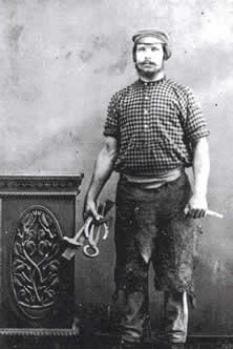
Henry Head
This photo is from 1870 and shows a young Henry posing for a photo with his tools in hand. Who was he? I'm sure when this photo was taken he would never of dreamed that his picture would be dug up from the archives of the John Oxley Library, Brisbane and displayed on the internet. I'm sure he was probably suitably impressed enough with the fact that a photograph could be produced at all. You can see that the tools haven't changed very much at all in the ensuing 137 years. Over time I will endeavour to find out more about Henry. All I know so far is that the photo was taken at Ipswich.
This photo is from 1870 and shows a young Henry posing for a photo with his tools in hand. Who was he? I'm sure when this photo was taken he would never of dreamed that his picture would be dug up from the archives of the John Oxley Library, Brisbane and displayed on the internet. I'm sure he was probably suitably impressed enough with the fact that a photograph could be produced at all. You can see that the tools haven't changed very much at all in the ensuing 137 years. Over time I will endeavour to find out more about Henry. All I know so far is that the photo was taken at Ipswich.
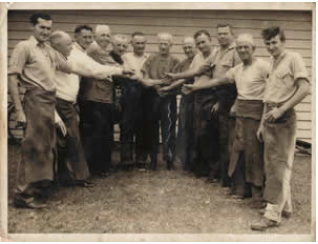
The photo right was taken in 1957. The farriers were there to congratulate one of the farriers on his retirement. The photo was taken at the back of the race day stalls at Eagle Farm. The gentlemen on the extreme left (Pat Burns) and right (Gary Jaenke) are the only ones still alive today.
Left to Right: Pat Burns, Bill Smith, Ces White, Tom New,Bill (Gunner)Burns, George Gomersall, Nobby Lyons, Stuart Kelly, Herbie Baker, Jimmy Gilshanan, Bill Stone, Gary Jaenke.
Left to Right: Pat Burns, Bill Smith, Ces White, Tom New,Bill (Gunner)Burns, George Gomersall, Nobby Lyons, Stuart Kelly, Herbie Baker, Jimmy Gilshanan, Bill Stone, Gary Jaenke.
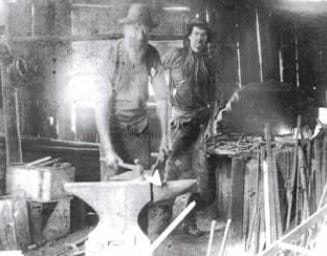
'John Oxley Library Queensland Neg: 139053'
The photo left is Henry 20 years later in 1890. The other man in the picture is unknown, but I would imagine he would be the apprentice of the shop.
The photo left is Henry 20 years later in 1890. The other man in the picture is unknown, but I would imagine he would be the apprentice of the shop.
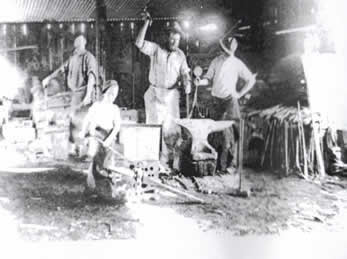
Samuel Pierpoint Snr
'John Oxley Library Queensland Neg: 140814'.
"The Globe Forge" owned by Samuel Pierpoint Snr. 1870's. Left to Right: John Pierpoint, Stanley Pierpoint(small Boy), Doug Robertson, Samuel Pierpoint.
The Pierpoint's had their Blacksmith shop in Stanthorpe and were wheelwrights as well as blacksmiths. Obviously it was a family affair, with 3 generations shown in the photo. The Pierpoint's are still in Stanthorpe today with the local Ford dealership under the banner of Pierpoint Motors.
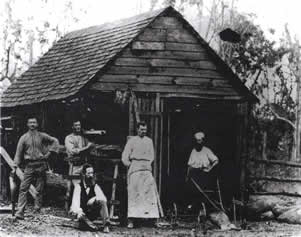
John Oxley Library Queensland Neg: 12197
Left: Photo of a blacksmith shop in Boonah. Unfortunately the people and the year of the photo are unknown. Judging by the style of the photo it would seem to be late 1800's. Almost every country town would have had at least one blacksmith shop. Hardware stores were few and far between, so the local 'smithy' was a vital part of the community. If you didn't have it he made it, if it was broken he fixed it
Left: Photo of a blacksmith shop in Boonah. Unfortunately the people and the year of the photo are unknown. Judging by the style of the photo it would seem to be late 1800's. Almost every country town would have had at least one blacksmith shop. Hardware stores were few and far between, so the local 'smithy' was a vital part of the community. If you didn't have it he made it, if it was broken he fixed it
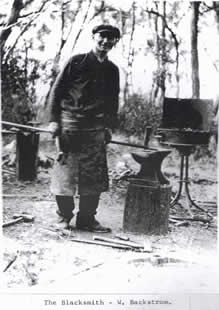
'John Oxley Library Queensland Neg: 71739'
The photo left is of a blacksmith on the Darling Downs 'W Backstrom'. Year unknown. He is shown here working outdoors, so maybe blacksmiths were mobile a lot earlier than we would all naturally assume. Many times blacksmiths would go out to stations and work for months on end making gate hinges and whatever else would was required. Some of these stations were several days ride to the nearest town so it wasn't practical to just 'nip' down to the blacksmith shop to pick up a few things. Notice that even in the heat of the fire he still wore long sleeves. Maybe he was aware of the dangers of sun exposure even back then.
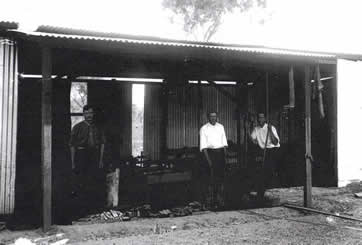
John Oxley Library Queensland Accession No: 77-5-6'
Blacksmith shop in Pittsworth in 1906. The people in the photo are unknown. In the heart of farm country this shop would've been kept busy making the implements that were needed for farming in the area.
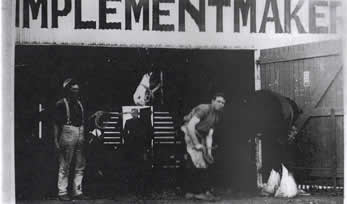
John Oxley Library Queensland Neg: 80'.
The photo left is also from Pittsworth in 1914. Not only did the local blacksmiths make the implements for the farmers, but they also had to keep the clydesdales that pulled the ploughs shod. Making the shoes for these horses would have been an everyday occurrence for the people who worked in these shops. Often there would be several blacksmiths and an apprentice or two all working in the same shop.
The gentleman shoeing this Clydesdale is William Arthur Costigan. Born December 5 and died July 11 1945. Many thanks to Gail White for providing the information, William was her Uncle.
The photo left is also from Pittsworth in 1914. Not only did the local blacksmiths make the implements for the farmers, but they also had to keep the clydesdales that pulled the ploughs shod. Making the shoes for these horses would have been an everyday occurrence for the people who worked in these shops. Often there would be several blacksmiths and an apprentice or two all working in the same shop.
The gentleman shoeing this Clydesdale is William Arthur Costigan. Born December 5 and died July 11 1945. Many thanks to Gail White for providing the information, William was her Uncle.
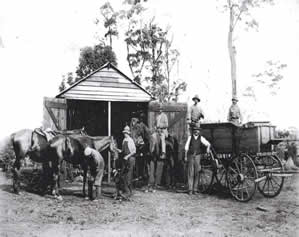
'John Oxley Library Queensland Neg: 76291
Blacksmith at work on a saddle horse. The photo was taken at Kilcoy. Year unknown.
Blacksmith at work on a saddle horse. The photo was taken at Kilcoy. Year unknown.
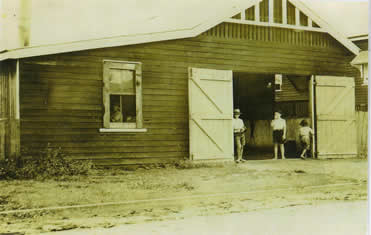
Stuart Kelly
Back in the 40's and 50's there were quite a few blacksmith shops dotted all around the northern suburbs of Brisbane. None are still in existence today (with the exception of Pat Burns shop at his house at in Deagon). Stuart Kelly had two shops around Ascot and Hendra and had several 'boys' working for him. These were the days when all the horses that were racing that day were shod at the races. Now they are all done before they get there. However there are still farriers at the races to ensure that every runner goes into the race with their racing plates intact.
This photo is circa 1952. The building is the blacksmith shop of Stuart Kelly. The shop was in Dobson Street, Ascot. Pat Burns worked for Stuart Kelly when he moved to Brisbane from Bundaberg. Pat recalls "I used to ride the tram to Newstead and then ride my bike to the blacksmith shop. Quite often when I arrived at 7am, there would already be 4 or 5 horses and their strappers waiting out the front". The children in the photo are unknown.
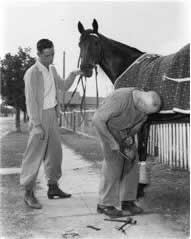
S. Kelly working on Kingship who had pulled up sore after a gallop.
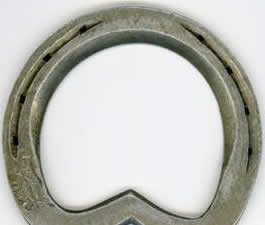
Left: An aluminium heart bar. The shoe has been cut from a sheet of aluminium which would have been quite painstaking. Shows the lengths they went to to get the things they needed back then.
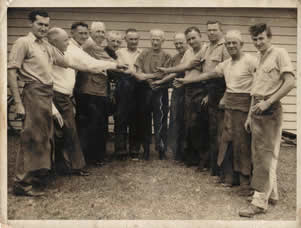
The photo left was taken in 1957. The farriers were there to congratulate one of the farriers on his retirement. The photo was taken at the back of the race day stalls at Eagle Farm. The gentlemen on the extreme left (Pat Burns) and right (Gary Jaenke) are the only ones still alive today.
Left to Right: Pat Burns, Bill Smith, Ces White, Tom New,Bill (Gunner)Burns, George Gomersall, Nobby Lyons, Stuart Kelly, Herbie Baker, Jimmy Gilshanan, Bill Stone, Gary Jaenke.
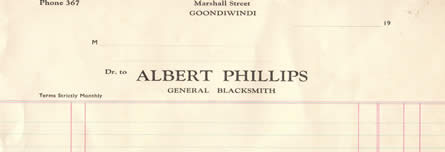
Albert Phillips
Albert Phillips had his Blacksmith shop in Marshall Street Goondiwindi from the early 1900's right through to the 1950's. As a general blacksmith in the town Albert would do alot of the horse shoeing as well as the general blacksmithing that was required by the stations, City Council as well as the public. The family still has members in the town of Goondiwindi. Albert's son went on to work in the blacksmith shop as well and his grandson went on to become a bank manager. So you might say that the family has had a long tradition of members becoming pillars of the community.
Below are some small snippets I have been able to find.
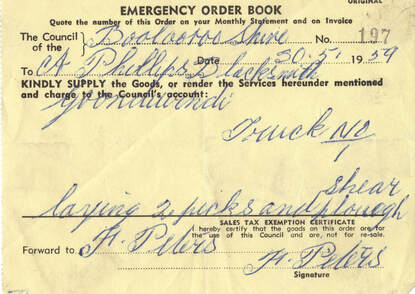
Left is a sheet out of the account book for Albert's blacksmithing business. Right is an order from the Goondiwindi Council for work.
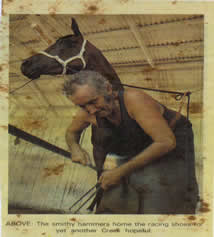
The 'Creek'
Albion Park or 'The Creek' as it was affectionately known was unlike any racecourse anywhere in Australia. The tight turning sand track made for exciting racing. Situated close to the Brisbane River it was not unusual for the races to be delayed while they waited for the tide to go out that had inundated the track. Retired farriers Pat Burns and Gary Jaenke were regulars at the meetings and can tell many a tale about the events of racing back in that era.
The photo above is of Pat Burns (PFBAQ Life Member) plating a runner at Albion Park at the last race meeting held there on the 30th December, 1981.
What a unique racing venue that sadly we will never see again. The tight turning sand circuit was suited to some horses but not to others. There are many stories of horses that couldn't win anywhere but when they got to the "Creek" they seemed to grow an extra leg. Victorians talk about the tight track at Moonee Valley, but it didn't come close to Albion Park. The jockeys would sit sideways like they were on a motorbike to get their mounts around the corners with the coarse sand stinging their faces as it was thrown back from the runners in front.
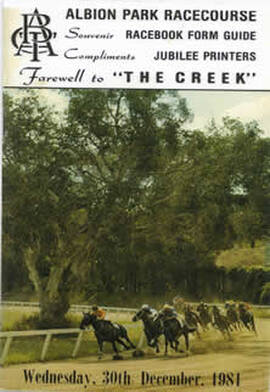
This race book has been kindly donated to us by Pat Burns. The Queensland Turf Club will be setting aside a section for farriers in the new racing museum at Eagle Farm racecourse and the book will eventually reside there.The last race to be run on that day was won by 'Lire News' who was trained by Jim Atkins in Toowoomba and was ridden by Michael Pelling. Lire News still holds the Class Record for the 1460 metre at 1.30.2. Needless to say it will never be broken now.
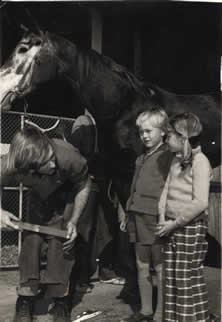
Ray Burnip
Ray Burnip was a farrier that worked in the Hendra area from the Fifties through to the Eighties. He is shown here working on one of Alby Pratt's horses at Nudgee. The children in the photo are trainer Don Cleal's son and daughter. Unfortunately Ray suffered from ill health towards the latter part of his career and had to retire prematurely. His was a great loss to the racing fraternity of Hendra. His contribution to racing has been recognised by this association and we are very proud to say that Ray has been inducted as a life member.
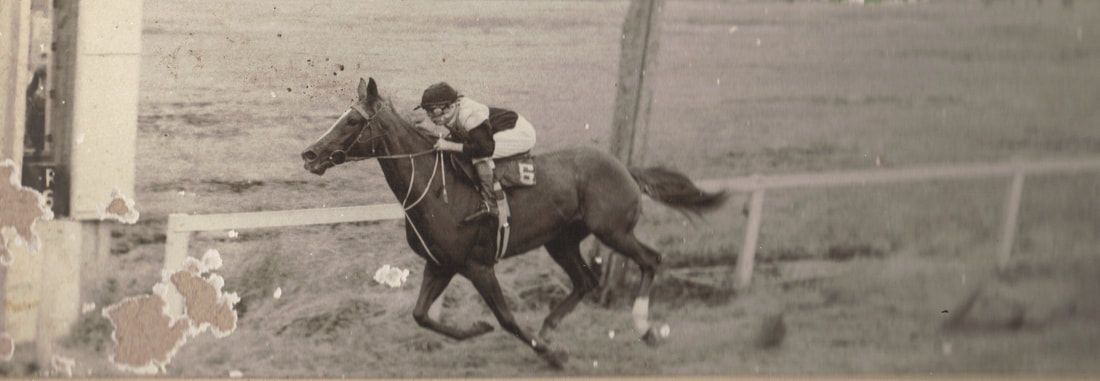
Other Lost Racecourses
Laidley
The photo above is of Lady Kadmos winning at the long since departed Laidley racecourse in 1960. Incidentally this was the first of approximately 1000 winners for well known Brisbane trainer the late Barry Miller.
Laidley
The photo above is of Lady Kadmos winning at the long since departed Laidley racecourse in 1960. Incidentally this was the first of approximately 1000 winners for well known Brisbane trainer the late Barry Miller.
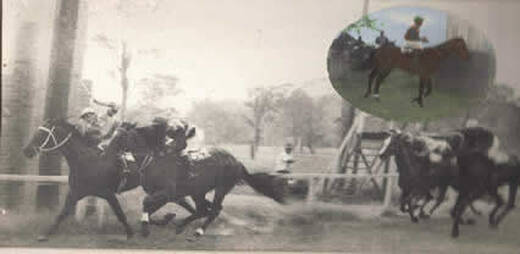
Oxenford
Above is Regal Glance winning at another long lost racecourse 'Oxenford' in 1960. Regal Glance (on the outside) was ridden by W. Galletly and trained by Alby Pratt. This is the only photo I have come across from Oxenford racecourse, it was kindly given to me by the Pratt family of Hendra. If you have any info or photos of this racecourse I would love to hear from you.
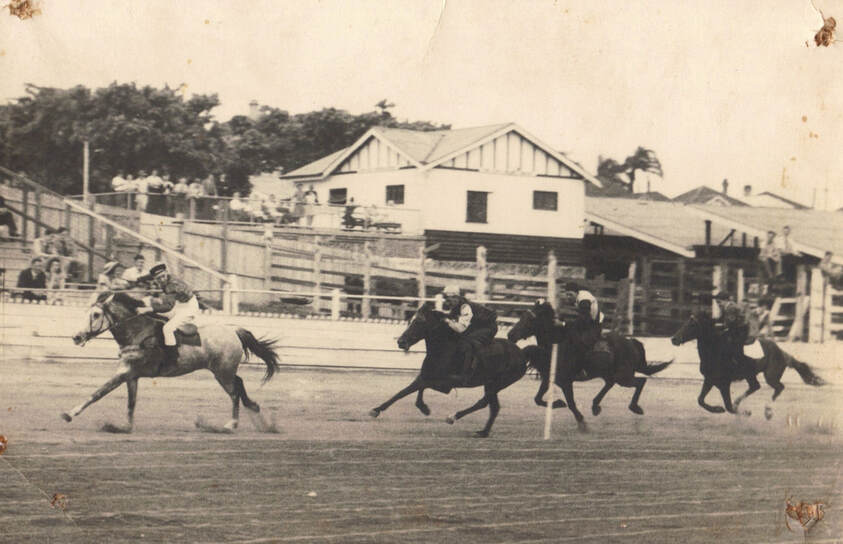
The Ekka
This photo is of a racecourse that you would never have guessed existed. This race is called a "pony speed test" and they were held regularly all over Brisbane.
The horse running second with a lap to go is "Kitty" with Alby Pratt in the saddle. She went on to win the final of the speed test on the Saturday night. The photo is from 1945.
